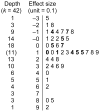Meta-analysis of quality-of-life outcomes from physical activity interventions
- PMID: 19448521
- PMCID: PMC3159686
- DOI: 10.1097/NNR.0b013e318199b53a
Meta-analysis of quality-of-life outcomes from physical activity interventions
Abstract
Background: Interventions to increase physical activity among adults with chronic illness are intended to improve quality of life and reduce disease complications or slow disease progression.
Objective: The aim of this study was to integrate quality-of-life outcomes from primary research studies testing interventions to increase physical activity among adults with chronic illness.
Methods: Extensive literature searching strategies were used to locate published and unpublished primary research testing physical activity interventions. Results were coded for studies that had at least 5 participants with chronic illness. Fixed- and random-effects meta-analytic procedures included moderator analyses.
Results: Eighty-five samples from 66 reports with 7,291 subjects were synthesized. The mean quality-of-life effect size for two-group comparisons (treatment vs. control) was.11 (higher mean quality-of-life scores for treatment subjects than for control subjects). The treatment group pre-post comparison effect size was.27 for quality of life. Heterogeneity was modest in two-group comparisons. Most design and sample attributes were unrelated to intervention effects on quality of life. Studies that exclusively used supervised center-based exercise reported larger quality-of-life improvements than did studies that included any educational/motivational content. Effect sizes were larger among unpublished and unfunded studies. The effect size for physical activity did not predict the quality-of-life effect size.
Discussion: Subjects experience improved quality of life from exposure to interventions designed to increase physical activity, despite considerable heterogeneity in the magnitude of the effect. Future primary research should include quality-of-life outcomes so that patterns of relationships among variables can be explored further.
Figures
References
-
- Berlin JA, Santanna J, Schmid CH, Szczech LA, Feldman HI Anti-Lymphocyte Antibody Induction Therapy Study . Individual patient- versus group-level data meta-regressions for the investigation of treatment effect modifiers: ecological bias rears its ugly head. Statistics in Medicine. 2002;21(3):371–387. - PubMed
-
- Brown SA, Upchurch S, Anding R, Winter M, Ramirez G. Promoting weight loss in type II diabetes. Diabetes Care. 1996;19(6):613–624. - PubMed
-
- Ciccolo JT, Jowers EM, Bartholomew JB. The benefits of exercise training for quality of life in HIV/AIDS in the post-HAART era. Sports Medicine. 2004;34(8):487–499. - PubMed
-
- Conn V, Hafdahl A, LeMaster J, Ruppar T, Cochran J, Nielsen P. Interventions to improve self-management among adults with type 1 diabetes: Meta-analysis of metabolic outcomes. American Journal of Health Behavior. 2008;32:315–329. - PubMed


